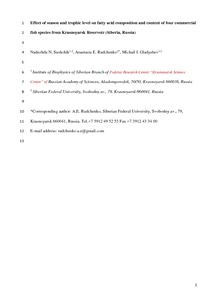Показать сокращенную информацию
Effect of season and trophic level on fatty acid composition and content of four commercial fish species from Krasnoyarsk Reservoir (Siberia, Russia)
| Автор | Sushchik, N. N. | |
| Автор | Rudchenko, A. E. | |
| Автор | Gladyshev, M. I. | |
| Дата внесения | 2018-02-07T07:34:08Z | |
| Дата, когда ресурс стал доступен | 2018-02-07T07:34:08Z | |
| Дата публикации | 2017-03 | |
| Библиографическое описание | Sushchik, N. N. Effect of season and trophic level on fatty acid composition and content of four commercial fish species from Krasnoyarsk Reservoir (Siberia, Russia) [Текст] / N. N. Sushchik, A. E. Rudchenko, M. I. Gladyshev // Fisheries Research. — 2017. — Т. 187. — С. 178-187 | |
| ISSN | 01657836 | |
| URI (для ссылок/цитирований) | http://www.sciencedirect.com/science/article/pii/S0165783616304015 | |
| URI (для ссылок/цитирований) | https://elib.sfu-kras.ru/handle/2311/70228 | |
| Аннотация | tTwo groups of factors, phylogenetic and ecological, are presently regarded as controlling fatty acidcomposition of fish, including essential eicosapentaenoic (EPA) and docosahexaenoic (DHA) acids. Envi-ronmental effects, e.g., trophic position, temperature and/or seasonality, were previously studied usingsums of fatty acids or only their level data. We tested the hypothesis that differences in trophic levels ofpiscivorous (pike and perch) and omnivorous (roach and bream) fish from a mesotrophic reservoir allowdiscriminating levels and contents of individual fatty acids, especially EPA and DHA. The more establishedmeasurements, i.e., stomach contents and carbon and nitrogen stable isotopes in fish muscles, were alsocarried out to provide linkages between the different ecological tracers, fatty acids versus stable isotopes,and matching the methods for long-term food sources (fatty acids and stable isotopes) and recent for-aging (stomach content analysis). We also studied a putative influence of seasonality. Similar to otherstudies, there were seasonal changes in fatty acid composition and contents of two fish, perch and roach,due to direct and indirect effects of water temperature. Meanwhile, the piscivorous and omnivorousspecies captured in the same month, were explicitly differentiated on a base of stable isotopes and fattyacids. Significantly higher percentages and contents of DHA in piscivorous fish, perch and pike, relativelyto those in roach and bream, likely indicated a higher trophic transfer efficiency for this essential fattyacid. All the fishes have commercial importance for regional fishery and are harvested from the studiedreservoir for human nutrition. Regarding content of EPA + DHA (mg g−1fish) as the indicator of nutritivevalue for humans, pike had the highest nutritive value, roach and perch had intermediate overlappedvalues, and bream was of the least benefit. | |
| Тема | Piscivorous and omnivorous fish | |
| Тема | trophic level | |
| Тема | season | |
| Тема | fatty acids | |
| Тема | stable isotopes | |
| Название | Effect of season and trophic level on fatty acid composition and content of four commercial fish species from Krasnoyarsk Reservoir (Siberia, Russia) | |
| Тип | Journal Article | |
| Тип | Journal Article Preprint | |
| Страницы | 178-187 | |
| ГРНТИ | 34.35.33 | |
| Дата обновления | 2018-02-07T07:34:08Z | |
| DOI | 10.1016/j.fishres.2016.11.016 | |
| Институт | Институт фундаментальной биологии и биотехнологии | |
| Подразделение | Кафедра водных и наземных экосистем | |
| Журнал | Fisheries Research | |
| Квартиль журнала в Scopus | Q1 | |
| Квартиль журнала в Web of Science | Q1 |

